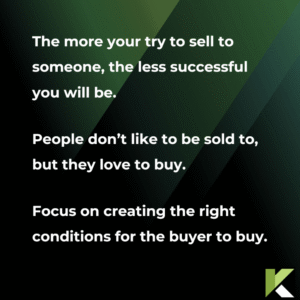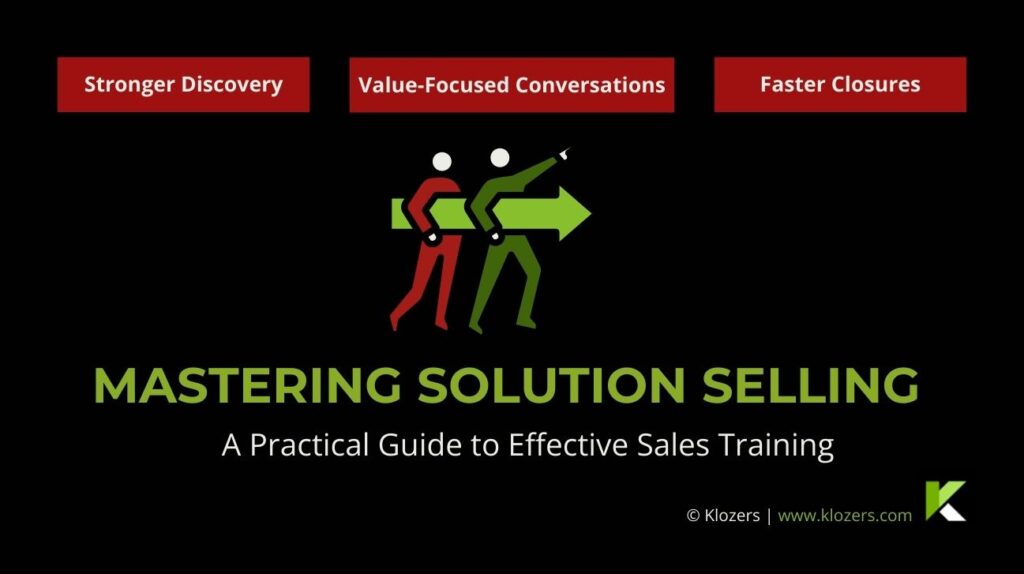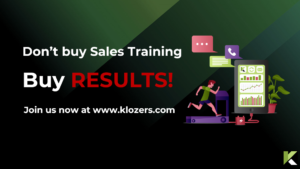Solutions Selling Training - Top Question From Google:
What Are the Four Steps of Solution Selling?
Solution selling is built around four key steps: qualifying the prospect, discovering their needs, adding value, and then presenting and closing. As HubSpot explains, it starts with figuring out if the person you’re speaking to is the right fit for your service. If you can’t genuinely help them, there’s no point going forward. Once you’ve confirmed there’s potential, your next step should be to uncover what’s holding them back. This usually involves identifying the pain points that affect how their business runs or how their goals are met.
After that, your focus should shift to showing how your solution connects to those challenges. This is where you move from selling a product to offering real value. Here, it is important that you are listing features that your service offers and helping them see how your offer can make a measurable difference in their world. Finally, you should present a clear vision of what their business could look like with your solution in place.
Free access to our best tools and templates
Introduction to Solutions Selling Training
Michael Bosworth introduced solution selling in the 1980s, and it still remains an effective sales strategy. Instead of focusing on specs and product details, this approach is built on empathy and trust and helps you show what your offer can do for the customer.
In today’s crowded market, where buyers have more information and options than ever, being able to sell a product isn’t enough because your customers are looking for a partner. They want someone who understands what’s holding their business back and can offer solutions that make a difference. That’s where solution selling comes in. It gives your team a clear way to lead conversations, ask better questions, and focus on what each client is trying to fix.
To do this well, you should take time to understand the customer’s world, their goals, the issues they’re facing, and how those challenges show up in their day-to-day work. Sometimes it’s outdated systems slowing things down. Other times, it’s poor data or teams not communicating clearly. Whatever the case, your job is to get to the root of it. Once you understand how those issues are holding them back, you can recommend a solution that fits their reality and supports them.
In this article, you’ll learn how solution selling training is built, why it works, and what it looks like when it’s done well in real sales situations.
Selling by Solving Real Problems
In a good solution-selling training, you should move beyond theory and into hands-on learning. What works better is putting your team in situations that reflect the challenges they’ll face in the field.
For example, if one of your reps is visiting a healthcare provider as an IT sales consultant, and the hospital administrator starts describing the long delays they have been having in discharging patients. Nurses are filling out forms by hand, records are stored in separate, non-integrated systems, and important updates get missed or delayed. If your rep is listening, they should realize this isn’t just about outdated technology. It’s a deeper issue that’s slowing down care, frustrating staff, and making it harder for the hospital to operate smoothly.
Rather than jumping into a product demo, the rep should walk the administrator through what a better process could look like. This could be digital forms that reduce paperwork, connected records across departments, or real-time updates between nurses and case managers. In that moment, the rep is offering a faster, more reliable discharge process, better patient outcomes, and fewer overtime hours for the team. By listening well and making the right connections, they’ve already moved through two critical steps of solution selling: discovery and adding value.
What Effective Sales Training Delivers
Effective solution selling training reveals itself through changed behavior on the job. You should see it in how your team shows up to meetings, how they handle conversations, and most importantly, in the results they drive. According to the Harvard Business Review, today’s business leaders are placing more emphasis on improving sales rep performance than at any point in the past fifty years. This shift has made coaching sales behaviours just as important as teaching product knowledge or sales tactics.
This focus is already leading to higher win rates, more reps hitting their targets, and a closer match between what’s being sold and what the customer needs. After going through solution selling training, for instance, a rep who used to begin every meeting with a product demo can now take a different approach. They begin by asking about the client’s goals and what’s getting in the way. Instead of jumping into what the product can do, they focus on what the client is trying to fix and how the offer can help. That simple shift often leads to shorter sales cycles, larger deals, and stronger relationships that last well beyond the close.

Avoiding a One-Size-Fits-All Approach
One of the most common mistakes teams make when trying to apply solution selling is treating it like a fixed script or a checklist of questions. Real sales conversations don’t follow a straight line, and they’re never one-size-fits-all. What works with one buyer might fail with another. A sales rep who connects easily with a tech-savvy startup founder might struggle to gain traction with someone in the public sector. You should expect your team to adapt in how they ask questions, how they frame the problem, and even the words they use to describe value, all need to shift depending on who they’re speaking to. This is where well-designed sales training makes a real difference, as it puts your team into real scenarios that unfold like actual sales conversations.
Actionable Tip:
Build role-play exercises around real client scenarios your team has faced in the past 90 days. Use actual objections, industry jargon, and decision-maker dynamics. This makes training practical, boosts confidence, and ensures reps can apply solution selling skills immediately in the field.
Final Thoughts
Solution selling has stayed relevant because it helps teams do what really matters, which is to solve the problems customers care about most. It might have a few things in common with other sales approaches, but what makes it different is the way it pushes you to slow down, listen more closely, and pitch something that fits. It’s not always the fastest method, and it takes more effort up front, but it tends to pay off in the long run. When a customer sees that you truly understand their challenge and can help fix it, they value that. So, whether you use solution selling on its own or alongside other strategies, remember that staying focused on what the customer needs will always take you further.






